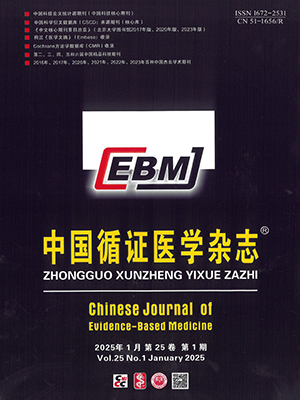| 1. |
Abrams P, Cardozo L, Fall M, et al. The standardization of terminology of lower urinary tract function: report from the standardization sub-committee of the International Continence Society. Neurourol Urodyn, 2002, 21(2): 167-178.
|
| 2. |
Zhang L, Zhu L, Xu T, et al. A population-based survey of the prevalence, potential risk factors, and symptom-specific bother of lower urinary tract symptoms in adult Chinese women. Eur Urol, 2015, 68(1): 97-112.
|
| 3. |
Milsom I, Coyne KS, Nicholson S, et al. Global prevalence and economic burden of urgency urinary incontinence: a systematic review. Eur Urol, 2014, 65(1): 79-95.
|
| 4. |
王小娟, 李静静, 万小娟, 等. 社区女性尿失禁患者求医意向及影响因素研究. 中华护理杂志, 2014, 49(04): 492-498.
|
| 5. |
Minassian VA, Yan X, Lichtenfeld MJ, et al. The iceberg of health care utilization in women with urinary incontinence. Int Urogynecol J, 2012, 23(8): 1087-1093.
|
| 6. |
令娟, 王明霞, 王琪, 等. 2015 年中国临床实践指南的报告质量分析. 中国循证医学杂志, 2018, 18(07): 721-728.
|
| 7. |
Hoffmann-Eßer W, Siering U, Neugebauer EAM, et al. Systematic review of current guideline appraisals performed with the Appraisal of Guidelines for Research & Evaluation II instrument-a third of AGREE II users apply a cut-off for guideline quality. J Clin Epidemiol, 2018, 95: 120-127.
|
| 8. |
韦当, 王聪尧, 肖晓娟, 等. 指南研究与评价(AGREEII)工具实例解读. 中国循证儿科杂志, 2013, 8(4): 316-319.
|
| 9. |
Appraisal of guidelines for research & evaluation Ⅱ instrument. Available at: https://www.agreetrust.org/wp-content/uploads/2017/12/AGREE-Ⅱ-Users-Manual-and-23-itemInstrument-2009-Update-2017.pdf.
|
| 10. |
周芬, 郝玉芳, 丛雪. 指南研究与评价工具 AGREE 价及各领域分值的补充解释及思考. 护理学报, 2018, 25(18): 56-58.
|
| 11. |
余红梅, 罗艳虹, 萨建, 等. 组内相关系数及其软件实现. 中国卫生统计, 2011, 28(5): 497-500.
|
| 12. |
Qaseem A, Dallas P, Forciea MA, et al. Nonsurgical management of urinary incontinence in women: a clinical practice guideline from the American College of Physicians. Ann Intern Med, 2014, 161(6): 429-440.
|
| 13. |
Committee on Practice Bulletins—Gynecology and the American Urogynecologic Society. ACOG Practice Bulletin No. ACOG Practice Bulletin No. 155: Urinary incontinence in women. Obstet Gynecol, 2015, 126(5): e66-e81.
|
| 14. |
European Association of Urology. Guidelines on urinary incontinence. Available at: https://uroweb.org/guideline/urinary-incontinence/.
|
| 15. |
NICE. Urinary incontinence in women: management. Available at: https://www.nice.org.uk/guidance/cg171.
|
| 16. |
AUA. Surgical treatment of female stress urinary incontinence: AUA/SUFU guideline (2017). Available at: https://www.auanet.org/guidelines/stress-urinary-incontinence-(sui)-guideline.
|
| 17. |
European Association of Urology. EAU guidelines on urinary incontinence in adults. Available at: https://uroweb.org/wp-content/uploads/EAU-Guidelines-Urinary-Incontinence-2016.pdf.
|
| 18. |
O'Reilly N, Nelson HD, Conry JM, et al. Screening for urinary incontinence in women: a recommendation from the women's preventive services initiative. Ann Intern Med, 2018, 169(5): 320-328.
|
| 19. |
Nambiar AK, Bosch R, Cruz F, et al. EAU guidelines on assessment and nonsurgical management of urinary incontinence. Eur Urol, 2018, 73(4): 596-609.
|
| 20. |
朱兰. 妇科泌尿手术内镜应用的历史发展和现状. 中华腔镜外科杂志(电子版), 2016, 9(2): 70-72.
|
| 21. |
《女性压力性尿失禁诊断和治疗指南(2017)》发布. 《女性压力性尿失禁诊断和治疗指南(2017)》发布. 中华医学信息导报, 2017, 32(11): 9.
|
| 22. |
Shekelle PG. Clinical practice guidelines: what’s next? JAMA, 2018, 320(8): 757-758.
|
| 23. |
AGREE History. Available at: http://www.Agreetrust.org/about-agree/agree-history/.
|
| 24. |
王雪格, 刘会范, 张道秀, 等. 女性压力性尿失禁患者盆底肌锻炼方案的构建与实证研究. 护理学杂志, 2016, 31(18): 30-32.
|
| 25. |
Herderschee R, Hay-Smith EJ, Herbison GP, et al. Feedback or biofeedback to augment pelvic floor muscle training for urinary incontinence in women. Cochrane Database Syst Rev, 2011, (7): CD009252.
|
| 26. |
刘景超, 朱兰. 盆底肌肉锻炼 (PFMT) 在女性压力性尿失禁中的应用进展. 现代妇产科进展, 2018, 27(1): 68-71.
|




